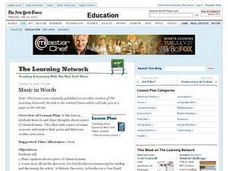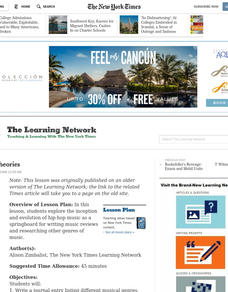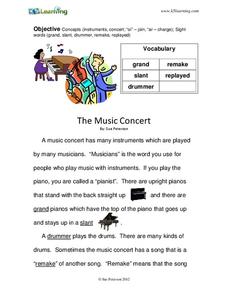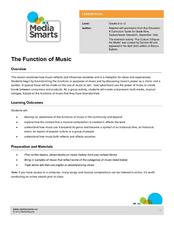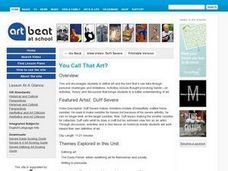Curated OER
Music in Words
Your class can build strong, well-represented opinions about the music they hear. They listen to, and share thoughts about, a piece of classical music. Then they write a piece of music or a poem, and analyze their peers' work and their...
Curated OER
Magical Musical Tour: Using Music Lyrics to Teach Literary Elements
While music lyrics are often used to teach literary elements, the richness of this resource comes from the wealth of exercises, activities, and support materials provided in the packet. Although designed for gifted learners, the...
Curated OER
Reading Basic Music Notes
First graders develop skills in reading music notes. In this reading music lesson plan, 1st graders clap and chant rhythm patterns and learn music vocabulary. Students also match patterns by listening to the teacher perform the pattern.
MENSA Education & Research Foundation
Magical Musical Tour: Using Lyrics to Teach Literary Elements
Language arts learners don't need a lecture about poetry; they listen to poetry every day on the radio! Apply skills from literary analysis to famous songs and beautiful lyrics with a lesson about literary devices. As...
California Department of Education
Hitting the Write Note: Writing a Proposal
To whom it may concern ... Scholars undergo the process of writing a letter to an authority figure. The lesson asks writers to compose a formal letter requesting a music therapy space. Pupils learn how to submit a project proposal to any...
Curated OER
Music Theories
Explore the inception and evolution of hip-hop music as a springboard for writing music reviews and researching other genres of music. Learners will read and discuss the Times' article, From Underground Music to Fashion Statement to then...
Education World
Black History Month Rap
Young scholars write a rap or hip-hop lyric about the life of a famous Black American. They explore famous Black Americans in history and explore how the rap form compares to other forms of poetic expression.
Curated OER
Ballet and Classical Music
Fourth graders explore ballet. For this dance and music humanities lesson, 4th graders practice ballet positions and play a card game using French ballet vocabulary. Students count beats in rhythm patterns and listen to classical music...
K5 Learning
The Music Concert
Second graders read an informational text passage on music concerts and then answer questions based on what they read.
New York State Education Department
English Language Arts Examination: June 2017
Plants prefer classical music to rock and roll. That's one of the claims in an informational passage that makes up part of a set of standardized assessment questions. The set is part of a larger collection of English language arts tests...
Curated OER
Customized Handwriting: Sixteenth Note
In this customized handwriting: sixteenth note worksheet, 1st graders change the style, font and text, then print the worksheet to practice handwriting.
Curated OER
Stop Signs, Musical Notes, Letters & Logos: Designing Symbols
Students develop an awareness of environmental print, such as signs, logos, brand names, and other print and non-print items that the children see and read in their neighborhood each day. They then engage in active problem solving as...
Curated OER
Ornament Notes
In this recognizing the musical notes on a staff worksheet, students identify and color the notes according to the accompanying code. Students color 9 ornament notes.
Curated OER
Syncopated Duet
Students work in pairs to compose a duet (with percussion instruments) that contains syncopated rhythm sequences. Each student will research a piece of music that they feel uses syncopation and will give a persuasive speech to the class.
Curated OER
Clef music note
In this clef music note worksheet, students view a picture of a clef music note and trace and write the word clef. Students trace and write the word 1 time each.
Film English
Music
Some emotions are indescribable, but sometimes you have to try! After brainstorming adjectives that describe emotions, pupils watch a quick film, at first with no sound. Partners share their adjectives and come up with descriptions for...
Curated OER
Adapting a Musical
Students transform literature into musical productions. In this integrated arts lesson, students discuss how musicals are written and produced. Students then select literature they are familiar with to adapt into musical productions.
Curated OER
The Function of Music
Explore concepts of audience, purpose and symbols in this lesson from Media Smarts that asks students to consider all the functions of music. Through a series of discussions and activities, your class will brainstorm possible functions...
Curated OER
Music: Sounds on the Farm
Singing is a great way to build memory, music, and verbal communication skills. Little ones sing the song, "Old Mac Donald had a Farm." They make the sounds of each animal on the farm paying attention to signaling cues, singing high, and...
Curated OER
You Call That Art? - Activity 1
Learners formulate a definition of art in the introductory lesson for a unit on various art forms. The learning emphasis is placed on Oregonian artist Duff Severe and reflective writing. Students compose an essay describing various art...
Curated OER
Using the Internet - Art and Design
An interesting resource that might work best in an upper level art course, this handout provides a list of nine websites where young artists can read and study about all forms of art. These online resources range from a dictionary of...
Curated OER
Half Note: Print and Color
In this word recognition worksheet, students trace the word "half note", write the word independently, and color the picture of the half note.
Curated OER
Whole Note: Print adn Color
In this word recognition worksheet, students trace the words "whole note", write the words independently, and color the picture of the whole note.
San Francisco Symphony
Music Reflects History
Exploring the baroque era can be exciting and fun when it's done thorugh the arts. Middle schoolers examine the music and art history of the baroque era through research. They use their findings and class notes to create an expository...
